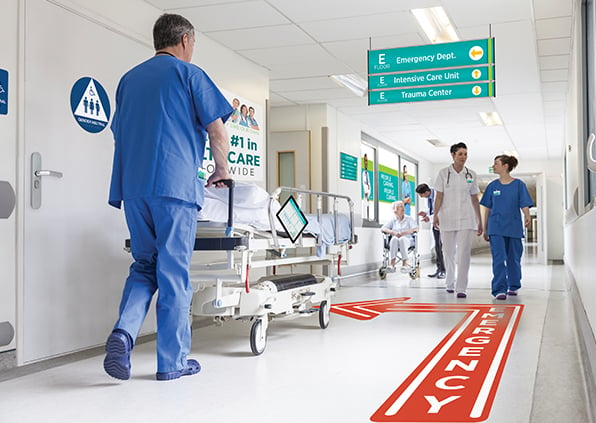It’s been estimated that the average American is exposed to as many as 10,000 advertising messages each day. Many of these messages are in the forms of signs and graphics, but not all of them are intended to “sell” to us per se. Wayfinding and directional signs are all around us and they are vital to the efficient navigation of any large physical space.
Most people likely have no awareness of the human factors engineering involved in creating a wayfinding signage system. However, anyone who has ever walked in circles in a poorly signed airport terminal, or missed the kick-off of a big game trying to find their seat, is painfully aware of its importance. The stakes become even higher as the emotional component escalates – such as when trying to navigate a hospital during a healthcare crisis.
The Science Behind Hospital Wayfinding Signs and Graphics
A landmark research study on the topic of wayfinding was conducted by Daniel Montello of the University of California-Santa Barbara and Corina Sas of Lancaster University in the U.K. The work was titled “Human Factors of Wayfinding in Navigation” and explored the psychology of human wayfinding in depth. As noted in the opening paragraph, the topic can be summed up as follows:
We navigate to the other side of the room, to the post office, to visit our
relatives in another town, or to vacation half way around the world. In order to navigate
effectively, we apply our psychological skills of perception, cognition, and motor behavior,
within the contexts of physical and social environments, and with the assistance of technologies
of information and transportation. There are consequently a host of human factors issues
relevant to navigation.
Sas and Montello’s work is a must-read for anyone who wants to understand why certain airports are less confusing, some stadiums make it easier to find your seat, or a given hospital feels less daunting in a crisis. It’s all a matter of understanding the psychology of how humans navigate a space.
Navigation requires accurate information – but not too much
In order to navigate a physical space, the human brain requires information. There must be a goal destination that is to be reached, we must understand what is in that environment (i.e., why we want to go there), and we must know where it is located. All of this information, of course, must be accurate and up to date.
However, there is such a thing as too much information. As noted by Montello and Sas, “It is
important that the information is sufficient but not more than sufficient. For instance,
excessively complete information can prevent us from focusing on relevant information by
distracting us with irrelevant information.” Translation: A good wayfinding signage system tells you everything you need to know but nothing you don’t.
Orientation is critical
In the words of poet and civil rights activist Maya Angelou, “You can’t really know where you are going until you know where you have been.” This perfectly sums up the concept of orientation. Montello and Sas note that efficient wayfinding requires that the “traveler” be aware of their current location relative to their destination and to the other things (places, objects, spaces) they will encounter in getting there.
The risk of being improperly oriented is a phenomenon known as “geographic disorientation.” You and I know it as getting lost. In most settings, getting lost results in mild frustration or inconvenience. However, in a hospital, geographic disorientation is commonly a source of anxiety. In extreme situations, it can even be life threatening.
Differentiation helps to overcome complexity
The more complex an environment, the more difficult it is to navigate. Unfortunately, few public spaces are more complex than a hospital. The sheer number of functions, specialties and levels of care in a large healthcare facility makes navigation a daunting challenge. Thankfully, the human brain offers us a way around this challenge.
Differentiation makes it easier to process a complex physical environment. Signage systems that use different sizes, shapes and colors will enable the traveler to navigate more confidently. The next time you are in a hospital, note how visual differentiation is reflected in the signs and graphics. Much like information, however, it’s possible to have too much of a good thing. Differentiation to an extreme merely adds to the noise of the environment and becomes a source of distraction to the traveler.
Design and placement matter
Montello and Sas describe the role of signs and graphics in navigation and are careful to point out that signage can disorient as easily as it orients. Signs must use fonts that are clearly legible from a distance, their overall design must be clear and simple, and they must contain enough information – but not too much. Failure to remember these bits of wisdom could make the space even harder to navigate.
Placement is equally important. Signage should be placed where the traveler requires information, such as at key decision points along the journey. The context of placement also matters. As Montello and Sas put it, “A perfectly clear sign may be confusing if it is placed in a sea of competing visual clutter.”
Two Other Considerations for Hospital Wayfinding Signage
The Society for Experiential Graphic Design, or SEGD, is a nonprofit professional association dedicated to those who “plan, design and build experiences that connect people to place.” In an interview with SEGD, human factors expert Virginia Grehshan noted two other things that warrant special attention when developing hospital wayfinding signage systems:
Find out what happens before the visit
As the saying goes, sometimes the left hand doesn’t know what the right hand is doing. This is often evident in hospital wayfinding challenges. Websites and packets of information provided to patients before a hospital visit do not always align with the signage systems they encounter at the facility, and vice versa.
A good hospital signage partner will seek to understand what is communicated with a patient before they ever set foot on hospital grounds. What terminology is being utilized? Which entrance are they being asked to use? Which elevator or floor is the patient being routed to? Knowing these things in advance can result in a signage system that creates a seamless navigational experience for the patient.
Pay special attention to the parking ramp
It’s easy to think that the “face” of a hospital is the smiling receptionist at the admissions desk, but it’s not. It isn’t even the brightly lit and beautifully designed front entrance. Most often, a hospital’s first impression is made by a concrete behemoth filled with parked cars.
The signage and wayfinding challenge for a hospital generally begins with the parking ramp used by patients and their visitors. Your navigation, orientation and differentiation strategies should all start there – as the traveler pulls their car into the ramp. By applying human factors engineering (HFE) principles to the signage at this initial point of contact, you can prevent anxiety and confusion before they occur.
Taylor Healthcare: A Leader In Hospital Signs and Graphics
Taylor Healthcare is a recognized leader in the management of healthcare information and communications. We have nearly a century of experience in healthcare and deliver solutions that help healthcare providers accelerate performance, attract and educate patients, enhance their safety and improve the quality of care.
One of the ways we do this is with wayfinding signage systems. Taylor Healthcare has decades of experience with signage systems for hospitals and provides a true end-to-end experience. From an initial signage audit and good/better/best recommendations through design and turnkey installation, Taylor Healthcare can partner with you to help elevate patient safety and satisfaction throughout the continuum of care.










